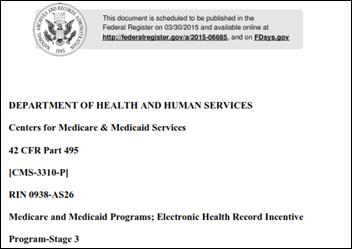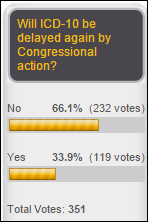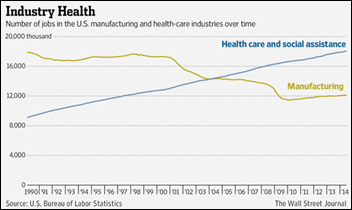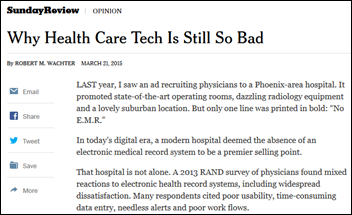I dont think anything will change until Dr Jayne and others take my approach of naming names, including how much…
Monday Morning Update 3/23/15
Top News

HHS, CMS, and ONC publish proposed rules for Meaningful Use Stage 3 and 2015 Edition EHR certification criteria. The announcement was posted as a Word document, bizarrely, and late on a Friday afternoon as is always the case. The Stage 3 rule is here and 2015 certification criteria here. Your comments are welcome, both here (any time) and at the Federal Register links (by May 29, 2015). I’ll be honest in saying that I’m so sick of the topic that I haven’t even bothered to read either document. I’m sure the many special interest groups will call out the parts they find objectionable and thus are probably the most needed. Feel free to chime in on parts you find interesting or surprising.
From Yours in Nomenclature: “Re: SNOMED-CT MOOC. It’s going to happen. I might sign up since my work bumps against it.” The College of St. Scholastica offers a free massive open online course (MOOC) called “Exploration of SNOMED-CT Basics” that starts April 20. Registration stays open until May 18 since the student just needs to finish the course by June 15. It offers 12 AHIMA CEUs. The instructor is Mike Grove, PhD of Accenture.

From Paul: “Re: Epic’s Deep Space architecture award. While I must congratulate Judy, I just left Verona with a sense of dismay at what our organization has been putting up with to build this place — north of $400 million by estimates — for a forum we’re only visiting once a year.” I think they should have concerts there. It would be fun to go to Verona for training and then walk over to see Rush or U2.
HIStalk Announcements and Requests

Two-thirds of poll respondents don’t think Congress will insert another surprise ICD-10 delay into SGR legislation, a belief that seems well founded in the draft versions presented so far. New poll to your right or here: which company do you trust least to make information exchange common and inexpensive? Of course I’m fascinated to learn why you voted as you did, so click the “comments” link afterward and explain.
I’ve emailed the 13 CMIOs who expressed interest in attending my HIMSS conference lunch on Tuesday, April 14. I still have a handful of spots left. I don’t often volunteer to pick up the lunch tab, so it’s a rare opportunity.
I’m really getting annoyed at half-wits who think it’s hilarious to use “FHIR” as “fire” in creating a lame pun for a headline or tweet.
Listening, as I was taking an extended drive and used Siri’s “what is this song” option to get the titles of the radio tracks I liked best as I constantly scanned: Christian rocker Matthew West’s “The Motions,” The Smashing Pumpkins with “Today,” a forgotten classic by the indefatigable Butthole Surfers, “Pepper,” new from Incubus, and my favorite song (nearly 40 years old) of the amazing Electric Light Orchestra.
HIStalkapalooza

HIStalkapalooza invitations have been emailed. Spam filter problems are rampant these days, so I’ve added a second level of checking: see this page, which lists who was invited in a somewhat de-identified format (first three letters of the last name, comma, and first two letters of the first name). We cannot accommodate walk-ins or guests, so the security people will admit only those who are on their full registration list. Some sponsors didn’t submit their guest lists in time, so if you’re being invited by one of the event sponsors and aren’t on the list, you should be getting an invitation directly from that sponsor.
I’ll take a second to again thank the HIStalkapalooza sponsors that are making it possible for a large number of folks to attend the event. Several of those listed are going above and beyond, with Sagacious, for example, running guest check-in and badge printing and Elsevier managing the traditional red carpet entrance. These companies are springing for dinner, drinks, and entertainment, so it seems reasonable that you click their links in return to see what’s new with them.
Platinum Sponsors
Elsevier
Santa Rosa Holdings
Gold Sponsors
Divurgent
Sagacious Consultants
Silver Sponsors
Aventura
CommVault
Falcon Consulting Group
Greenway Health
PatientSafe Solutions
Sunquest
Thrasys
Validic
Speaking of red carpet, here are skeletal details of the ever-popular HIStalkapalooza fashion awards, where your hot shoes will be burning down the avenue (Dearborn Street in this case). We’ll have four winners: best shoes male and female and then best overall appearance, also male and female, which will earn the HIStalk King and HIStalk Queen sashes, since like high school, we overly emphasize appearance because it’s all we have time to evaluate. Plan to enter early (maybe 6:45 to 7:15) via the red carpet, where our distinguished judges will cast their critical eyes feetward and then full body. Your regular host Jennifer Lyle of Software Testing Solutions serve as expert along with one of our patient scholarship winners Amanda Greene, who was involved with the red carpet at the Oscars this year and who works with fashion magazines. We’ll bring the four winners up to the stage to be sashed.
Last Week’s Most Interesting News
- A proposed Congressional SGR “doc fix” bill would make health IT interoperability a national priority to be achieved by the end of 2018 and proposes to penalize those who intentionally obstruct it.
- A contracting billing company’s employee falls victim to a phishing scam, exposing the information of 14,000 patients of Sacred Heart Health System (FL).
- Cerner and Athenahealth chide Epic via Twitter for its non-participation in CommonWell following its negative comments about the organization in congressional testimony.
- Premera Blue Cross discovers that hackers have had access to its 11 million patient records since May 2014.
- Meditech reports full-year 2014 results that include an 11 percent drop in revenue and profits that were reduced by 7 percent, although the company had previously restated its financials and that change may have affected the totals.
- CHIME offers a $1 million prize for an idea or technology that increases patient ID matching from the current 80 percent to 100 percent, although presumably members of Congress who could enact national patient identifier rules are not eligible.
- Implementation of New York’s mandatory e-prescribing law is delayed for a year, to March 27, 2016.
Webinars
March 31 (Tuesday) 1:00 ET. “Best Practices for Increasing Patient Collections.” Sponsored by MedData. Presenter: Jason Bird, director of client operations, MedData. Healthcare is perhaps the last major industry where the consumer does not generally have access to what they owe and how they can pay for their services. Collecting from patients is estimated to cost up to four times more than collecting from payers and patient pay responsibility is projected to climb to 50 percent of the healthcare dollar by the end of the decade. Learn how creating a consumer-focused culture, one that emphasizes patient satisfaction over collections, can streamline your revenue cycle process and directly impact your bottom line.
Acquisitions, Funding, Business, and Stock
Vince Ciotti has been tracking vendor annual revenue for decades. Here’s the first installment as he introduces the episodes to follow. He confirms the feeling I’ve had that HITECH goosed company revenues for a couple of big years, but that has tailed off and left a lot of software and consulting vendors scrambling to resize themselves appropriately.
People


Valence Health hires Kai Tsai (PwC Consulting) as EVP of consulting services and strategic initiatives and Mary C. Anderson, MD (Rush University Medical Center) as medical director of population health.
Karen Wavra (Allscript) joins Beacon Partners as Cerner practice director.
Announcements and Implementations
The headline “El Camino says goodbye to paper medical records” wasn’t written during its TDS implementation in the 1970s – it describes El Camino Hospital’s (CA) $125 million move to Epic.
Surescripts names 24 health systems and technology vendors for its “2014 White Coat of Quality Award” for electronic prescribing.
This is a scary graph. Healthcare is the highest-employing industry in 35 states.
An editorial in the Burlington, VT paper applauds an announcement by the governor that if Optum can’t get the state’s insurance exchange working by October, he’ll shut it down and move to the federal exchange. The state will have spent $198 million in federal taxpayer dollars by the end of 2015, with unimpressive results following screw-ups by CGI that resulted in its replacement by Optum.
Acting VA CIO Stephen Warren says that even though the DoD is shopping for a commercial EHR, the VA will stick with VistA because it was developed for patient care rather than built around billing as were commercial systems.
Technology
Good Morning America goes inside Apple’s secret fitness lab, where employee volunteers tested various sensors and technologies over the past two yeas without knowing their work was for the development of Apple Watch.
Other
A Virginia Peninsula newspaper points out that the region is one of the first in the country in which all competing health systems (Bon Secours, Riverside, Sentara, and Chesapeake Regional Medical Center) use the same EHR, Epic in their case. Like a lot of newspapers and marginally informed pundits, this article mistakes HITECH as being part of the Affordable Care Act, but this one takes it a step further in proclaiming that hospitals didn’t start testing EHRs until the 1990s and that just two major players remain (Cerner and Epic, forgetting about still-common but somewhat fading Meditech).
UnitedHealthcare runs a cute commercial that features an ICD-9 code and virtual visits.
Bob Wachter, MD, pitching his new book, writes a New York Times editorial whose content he summarizes via Twitter as “Why health IT is so bad and how to make it better.” The former was mostly anecdotes and I didn’t see much of the latter: his suggestions are: (a) train doctors to focus on the patient, not the computer; (b) create new ways to practice provider teamwork in the absence of a shared chart; (c) create federal policies that promote interoperability; (d) increase collaboration between academic researchers and software developers. Doctors may hate EHRs, but all it took was $44,000 in federal money to get them to use them. My argument would be that doctors should redesign the encounter system so they don’t need to use computers at all unless they need its help — doctors are the only professionals (accountants, lawyers, psychologists, plumbers) who key their own information into the computer instead of focusing entirely on the paying client sitting in front of them, and not only that, do most of their keystroking for the benefit of someone other than themselves. You could argue that medicine is the only profession that is practiced as a team, which might hit Bob’s second point, but I’d still say bring on the scribes and let doctors be doctors and not the medical equivalent of the grocery store checkout clerk. Everybody agrees that the information needs to be recorded, but it’s not reasonable that the highest-paid professional in the medical food chain be the one doing it.
Bob Wachter tweeted out an interesting excerpt from his book as he quoted National Coordinator David Brailer responding to the question if ONC would shrink itself as the HITECH money runs out. “Bureaucracies don’t retrench,” Brailer said. “ When a bureaucracy that starts out as the Candy Man runs out of candy, it goes dark and turns into Regulatory Man.”

Anyone who attended HIMSS09 in Chicago saw the weather change from a near-blizzard on Sunday to pretty good later in the week. Here’s what the not-so-bad weather looked like at O’Hare on April 12 of previous years (the Sunday opening day of this year’s conference):
2014: low 42, high 69, rain 0.43 inches.
2013: low 34, high 45, trace of snow.
2012: low 40, high 66, no precipitation.
2011: low 36, high 68, no precipitation.
2010: Low 48, high 63, no precipitation.
The family of a Virginia radio personality who died after routine hernia surgery is awarded around $2 million from the hospital and its PCA pump manufacturers. Nurses mis-programmed the pump and delivered five times the ordered dose of narcotic, which just about everybody agrees was because of the device’s complexity, although the manufacturer claims the nurse hadn’t been properly trained, didn’t monitor her patient, and waited eight minutes after finding the patient unresponsive before calling for help.

This photo, which a paramedic took surreptitiously as a California ED doctor grieved after his 19-year-old patient died, has received a lot of Internet attention after being posted on social media. Minutes later, the doctor had moved on to his next patient with his game face on. It’s a good reminder that a hospital is just a very clean hotel with a lot of expensive executives and non-clinical hangers-on – lives get saved, as they do on the battlefield or in an ambulance, by a well-trained fellow human who is willing and able to help.
Sponsor Updates
- Shareable Ink’s ShareQuality technology is featured in Nashville Medical News.
- Voalte CEO Trey Lauderdale shares his belief that “With Apple ResearchKit, mHealth Springs Forward.”
- Zynx Health will exhibit at the 2015 Population Health Colloquium March 23-25 in Philadelphia.
- The SSI Group and ZirMed will present at the Region 4 Mid-Atlantic HFMA Education Conference March 24 in Baltimore.
- Verisk Health will exhibit at the AMGA Annual Conference March 23-26 in Las Vegas.
- Xerox Healthcare asks, “Does Better Healthcare Require Better Patients?”
- Sunquest Information Systems will exhibit at the 2015ACMG Annual Clinical Genetics Meeting March 25-27 in Salt Lake City.
- PMD offers “Telemedicine: The Work of the Gods.”
- MedAptus, PatientKeeper, and Passport Health will exhibit at the AMGA 2015 Annual Conference March 23-26 in Las Vegas.
- The local business paper interviews Quest Diagnostics CEO Steve Rusckowski about the company’s recent successes and future plans.
- MedData will exhibit at the OHIMA Annual Meeting & Trade Show March 24-25 in Columbus, Ohio.
- MEA I NEA CEO Lindy Benton discusses the importance of improving practice communications on eHealth Radio.
- Navicure posts “Price Transparency: What does it have to do with Patient Engagement?”
- NVoq offers how to “Avoid Those ‘Few Extra Clicks’ and Improve EMR Workflow.”
- Nordic releases the second episode of its HIT Breakdown podcast entitled, “What does a great population health program look like?”
- Park Place International publishes a blog on “Winders Server 2003 End of Life and Active Directory.”
- Orion Health and Sandlot Solutions will exhibit at the 12th Annual World Health Care Congress March 22-25 in Washington, D.C.
- NTT Data will exhibit at the CIO Summit March 22-24 in Chicago.
- Perceptive Software’s In Context blog addresses “Hospital IT: Beyond the EHR.”
- BBC’s Click Tech program features the Oneview Healthcare solution used by UCSF Medical Center (CA).
Contacts
Mr. H, Lorre, Jennifer, Dr. Jayne, Dr. Gregg, Lt. Dan.
More news: HIStalk Practice, HIStalk Connect.
Get HIStalk updates.
Contact us online.






@bobwachter
I would like to know which Phoenix area hospital recruited by stating it did not have an EMR.
#mu3
Are doctors taking care of suits or patients? Just wondering.
really? “non-clinical hanger on”?
I get it – clinicians are great people. I love working with them. It’s why I work at a hospital and not for an insurance company or something else. But us “hangers on” are part of the team too. I guess we can all just not show up to work tomorrow…. doesn’t seem like we’re needed.
I’m probably having an emotional reaction to the comment and missing your larger point, but you don’t need to make that point by taking a shot at the careers of the “hanger-on”
Thanks.
RE: Wachter and Why HIT is Still So Bad. Absolutely agree that we have not taken advantage of HIT to make life easier for physicians (or other staff), and only occasionally used it to make life better for patients (mostly around patient portals and legible documents vs. high level use of IT… although analytics is getting us in the game). And fully agree that we have used computers to give doctors more busywork rather than less (although let’s share some of that with govt and insurance regulations gone amok as well over the past two decades). The most efficient docs have figured out how to use scribes (whether with paper or EMRs)… such as Optho, Derm and Ortho – all who can see 50+ patients a day. However, that is often also because they (1) Are able to focus on single organ and relatively straightforward issues, and (2) Often are paid for procedures rather than critical thinking… and sometimes in a bundled manner meaning that their time and documentation in a visit can be minimal. For PCPs, it’s often the opposite- we need to deal with multiple organ systems and our payments are based on how much we document (and are significantly less for the same amount of time as a proceduralist). With that said, some PCPs have figured out how to use scribes in various ways and I do think it is something to explore… for now it will be actual people (whether onsite or listening in virtually), although eventually I assume the computer will be able to listen and “watch” us, document what we do and say, predict what we need, and let us get back to focusing on taking care of patients rather than taking care of “business” (of documenting). As that happens – we will hopefully see a world of happier docs with more time and access for patients – and HIT itself becoming just some background noise we forget is even there. Well, a doc can dream! 🙂
Stage3 draft rules…what’d you say? Uninteresting??
Ok check these out:
1) For physician providers (EP) they can use multiple certified EHRs to meet MU percentage criteria. For example EHs must attest to meeting at least 50% of their patient encounters using a Certified EHR. But fs a doc practices in multiple settings, say his office, a hospital, rehab, and long term care facility the fifty percent can be met be adding all together – if ALL run ONC Certified products. What this means if you are a vendor of a specialty product for a rehab, or LTC, etc. it behooves you top get your CPOE component certified.
2) In Stage 2 providers needed to attest to adhering with HIPAA rules. In Stage 3 ONC is getting very specific and requiring providers to attest to doing a HIPAA Risk Analysis as part of any install and /or system upgrade. As a vendor this means you most likely be required by your client to assist in this process and insure your product meets all HIPAA compliance requirements…which are extensive.
3) Providers must increase ERx volumes from 40% to 80%
4) Providers must meet CPOE targets for: Medications orders=80%, Labs and Xray = 60%
5) Patient access via portals must meet: 80% availability with at least a 25% access rate. This means at least 25% of the providers patients must download, view or transmit (DVT) their EHR information after service. This target was 5% in Stage 2 and many providers complained it was unreasonable. Here’s my suggestion to get the volume up. Tell your clients/patients that if they access their EHR online they will be entered in a raffle to win a Caribbean cruise!
6) More DVT – 25% of your patients must enter their own unique data, such as family history updates, dietary supplement info, home meds, family history, etc. Or in some way update/revise the EHR data the provider entered. Again how to get them to do this? Win a cruise!
7) Transfer of care documents, CCR/CCD. No significant change in content or format, but you must receive at least 40% for admits/referrals of current patients, 80% for new, and send at least 40% for external referrals.
8) Lastly there had been a loud cry from provider associations to cut the data collection time from a year to 90 days. No soap. It remains at a year.
Couple this with the SGR proposal that ONC publish an indepth RFP function feature list for all certified products and you have bureaucratic nirvana!
Non-clinical hanger-ons, like the majority of software developers you talk about and consultants and vendors you gladly take sponsorship money from.
According to Wikipedia, “The Health Information Technology for Economic and Clinical Health Act, abbreviated HITECH Act, was enacted under Title XIII of the American Recovery and Reinvestment Act of 2009 (Pub.L. 111–5).” The hhs.gov website states: “The Health Information Technology for Economic and Clinical Health (HITECH) Act, enacted as part of the American Recovery and Reinvestment Act of 2009, was signed into law on February 17, 2009, to promote the adoption and meaningful use of health information technology.” HITECH is, in fact, part of ARRA.
Hit enter too soon. HITECH is, in fact, part of ARRA (the “stimulus package”) rather than PPACA, which was signed into law the following year. You are correct that the two pieces of legislation are often confused with each other.
I agree with “just one of the hangers on”. The unfortunate reality is without the infrastructure, the compassionate doctor pictured would not have a place to perform his job.
Re: Epic’s Deep Space architecture award
I am glad that my hospital’s bond ratings agency is not seeing the cost of that spectacle or they may look more into the level of my ongoing operating costs which funded it.
The UnitedHealthcare commercial is hilarious!
The e-mail linking me here asked me “when it comes to interoperability, who do you most distrust most?”
Read that again – “most distrust most.”
So I spent most of the day making a list of who I most distrust, from who I most distrust least all the way up to who I most distrust most.
Then I realized it was probably a typo. what a waste of several good hours.
419er
I have to second Paul’s observation regarding Epic Deep Space, and the campus in general. It’s a beautiful campus, and I love to visit. It’s also upsetting as someone who has been an Epic customer for a long time. Considering the cost of everything on campus, not just Deep Space, the cost for Epic has probably been in the billions.
Contrast that with the fact that for the past several years Epic has been a shadow of what they were when we had just signed on with them. Everything is slower, and the company that used to be able to whip up fixes and creative development for us doesn’t even remember how to do that anymore. We’ve had change requests that have been discussed with Epic for months and we can’t even get a decision to proceed on them, to say nothing of how often they either won’t fix problems or send us fixes that break things. The people we escalate to are either clueless or arrogant, and the assumption seems to be that we’re wrong for even wanting something.
There’s one TSer I’ve worked with at Epic for years, and has been pretty candid with me when I share some of these frustrations and observations. She tells me that just about everyone has gotten a new customer assigned since campus construction really took off, and there is just too much on everyone’s plate compared to what was typical earlier.
In any case, as a customer it kills me to see how billions of our dollars are being spent for what we’ve been getting. It feels like the whole campus is about attracting new customers, and it used to be that what attracted new customers was Epic’s reputation for serving the old customers.
My feelings on Epic’s campus are not as concerned as what was expressed above, except when it comes to Deep Space. We need Epic to attract and retain strong employees. Nice office buildings feel like they can help there. Deep Space feels unnecessary. I kind of wonder after XGM if the major purpose of splitting UGM into various parts was to hide the fact that despite all that money spent Deep Space was barely big enough for its debut at UGM last year.
I share in the concerns expressed above regarding Epic’s overall decline in maintaining the applications. They’re not in a position where we’re looking elsewhere from my perspective so much as they’ve just more closely resembled a lot of their other large competitors. We still love Epic, but they are slower, more bureaucratic, taking their customers more for granted. Feels a lot like rank-and-file employees can’t take initiative, and we’ve also had similar experience to the prior poster when it comes to interactions with leadership. Judy and Carl seem to listen, but have far less time. The various people they delegate us to over the past few years feel more abrasive, like their job is more to enforce orthodoxy. And creeping into the mix have been people who just don’t bring a lot of value into an escalated discussion. That last point is very new for us. When Epic was smaller you always felt that when you moved up their management chain you were talking to exceptional experts.
I do wish they could recapture some of their pioneer spirit.